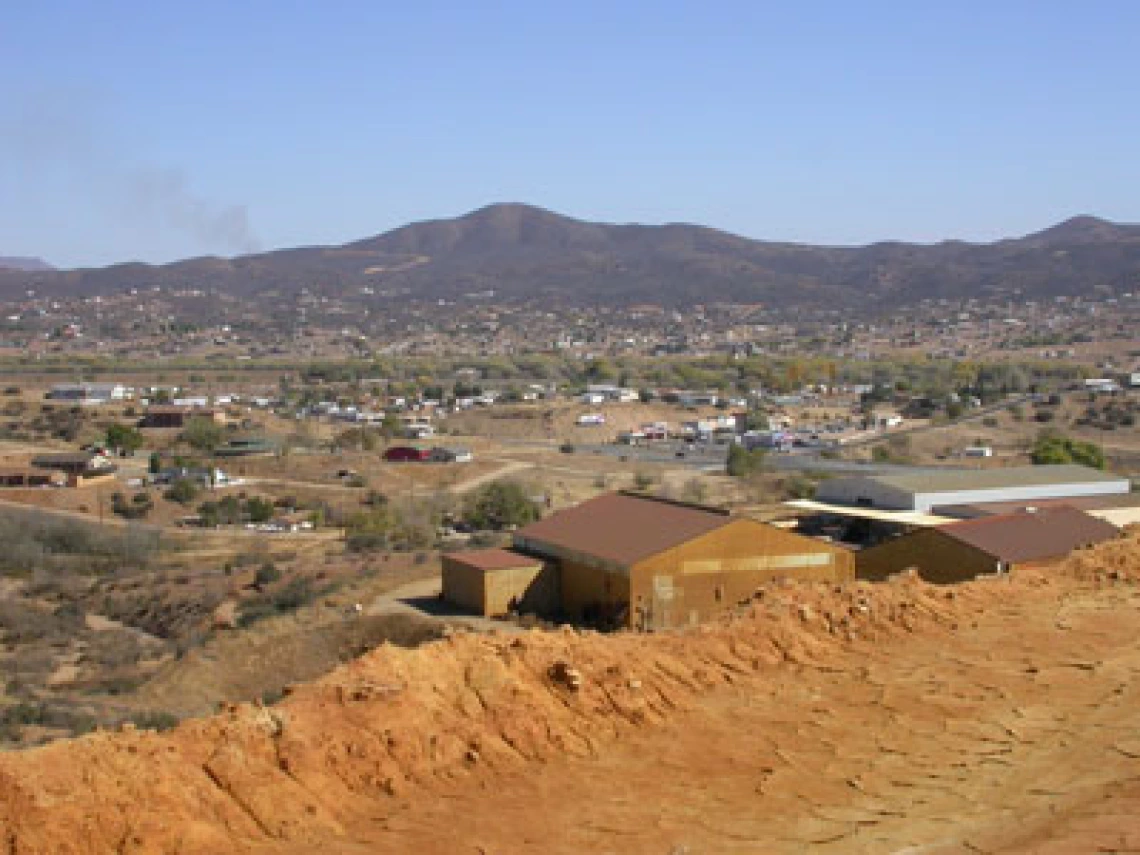
Looking out over Dewey-Humboldt from the Iron King mine tailings.
Summary
Thousands of communities in the US Southwest may be impacted by legacy mine tailings, yet little is known about pathways of exposure to metals from these mine tailings. Knowing more about these exposures is particularly important for children, who often have greater exposures because of their unique activity patterns, and whose developing bodies may be more susceptible to these exposures.
Drs. Paloma Beamer, Miranda Loh, and Walt Klimecki are working to better understand exposures to metals for children living near the Iron King Mine and Humboldt Smelter Superfund Site in Dewey-Humboldt, AZ. Through analysis of collected samples and a series of questionnaires, they will determine levels of exposure and sources of contamination for seven different metals: aluminum; arsenic; beryllium; cadmium; chromium; nickel; and lead. Environmental samples (water, yard soil, and house dust) were collected from households within five miles of the Superfund site. Biological samples (urine, toenails, and blood) were collected from one or more children ages 1-11 living in the households. Participants have received personalized report-back packets detailing their household’s results in the context of the larger study.
Significance
This study has the potential to inform the development of future interventions aimed at decreasing metals levels in homes near legacy mining sites.
Specific Aims
- Determine whether exposures of children ages 1-11 to selected metals (Al, As, Be, Cd, Cr, Ni, Pb) are higher than average levels in the US population according to national studies.
- Determine whether the biological and environmental sample concentrations show a spatial gradient from the site.
- Determine whether environmental concentrations and exposures estimated with those measurements predict biomarker levels.
- Validate and utilize predictive models of metal-contaminated dust exposure in Dewey-Humboldt to determine outdoor-to-indoor indoor transport and factors that affect this transport for these metals. Such models would be useful in future exposure assessments of contaminated sites where outdoor-to-indoor transport of dust is of concern.
Publications
2014 Beamer, P.I., Sugeng, A.J.,** Kelly, M.D.,** Lothrop, N., Klimecki, W., Wilkinson, S.T., Loh, M. “Use of dust fall filters as passive samplers for concentrations in air for communities near contaminated mine tailings.” Environmental Science: Processes & Impacts. Emerging Investigators Special Issue. 16(6): 1157-1536. PMID: 24469149; PMC: 4038653.
2015 Lothrop, N., Wilkinson, S.T., Verhougstraete, M., Sugeng, A.**, Loh, M.M., Klimecki, W., Beamer, P.I. “Home Water Treatment Habits and Effectiveness in a Rural Arizona Community.” Water, 7(3), 1217-1231.
2016 Loh, M., Sugeng, A.**, Lothrop, N.**, Klimecki, W., Cox, M., Wilkinson, S.T., Lu, Z., Beamer, P.I. Multimedia Exposures to Arsenic and Lead for Children Near an Inactive Mine Tailings and Smelter Site. Environmental Research, Volume 146, 331–339.
2016 Ramirez-Andreotta, M.D., Brody, J.G., Lothrop, N.**, Loh, M., Beamer, P.I., Brown, P. “Reporting Back Environmental Exposure Data and Free Choice Learning.” Environmental Health, doi: 10.1186/s12940-015-0080-1.
2016 Beamer, P.I., Klimecki, W.T., Loh, M., Van Horne, Y.O.**, Sugeng, A.J.**, Lothrop, N.**, Billheimer, D., Guerra, S., Lantz, R.C., Canales, R.A., Martinez, F.D. “Association of Children’s Urinary CC16 Levels with Arsenic Concentrations in Multiple Environmental Media.” Int J Environ Res Public Health, 13, 521.
2016 Ramirez-Andreotta, M.D., Brody, J.G., Lothrop, N.**, Loh, M., Beamer, P.I., Brown, P. “Improving Environmental Health Literacy and Justice through Environmental Exposure Results Communication.” Int J Environ Res Public Health, 13, 690.
To access the “Summary of Study Results” press here

